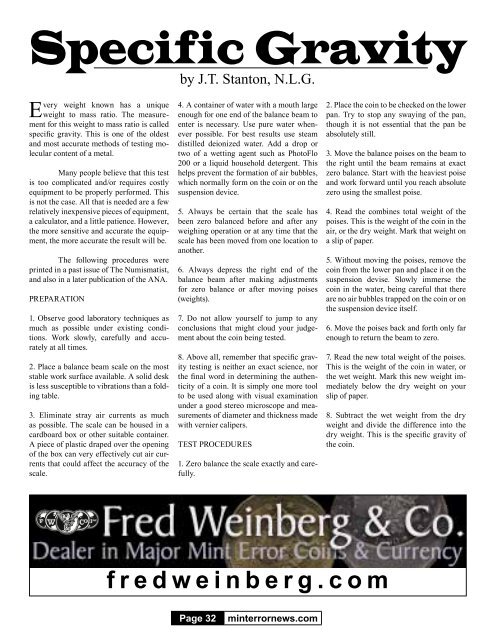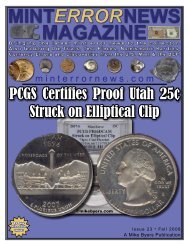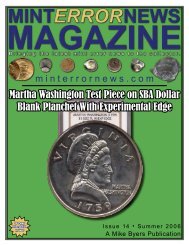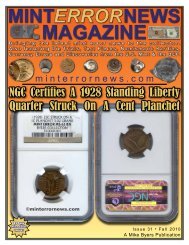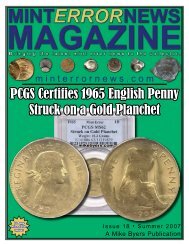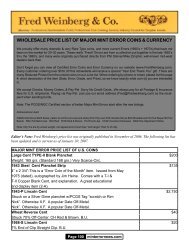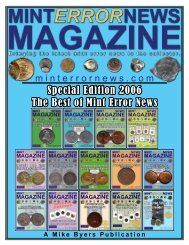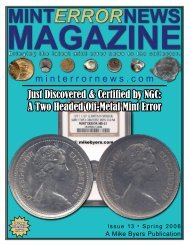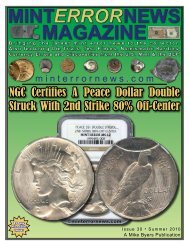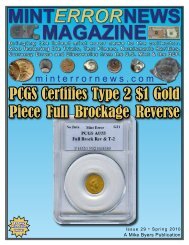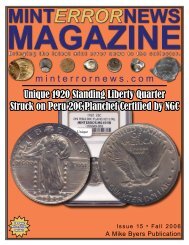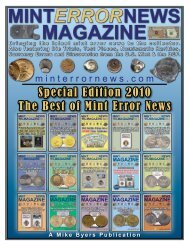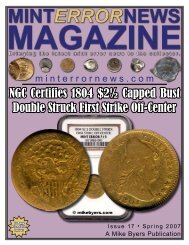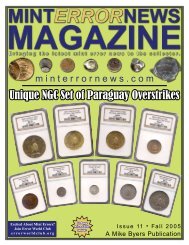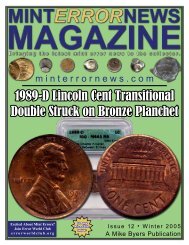Issue 1 - Mint Error News Magazine
Issue 1 - Mint Error News Magazine
Issue 1 - Mint Error News Magazine
You also want an ePaper? Increase the reach of your titles
YUMPU automatically turns print PDFs into web optimized ePapers that Google loves.
Specific Gravity<br />
Every weight known has a unique<br />
weight to mass ratio. The measurement<br />
for this weight to mass ratio is called<br />
specific gravity. This is one of the oldest<br />
and most accurate methods of testing molecular<br />
content of a metal.<br />
Many people believe that this test<br />
is too complicated and/or requires costly<br />
equipment to be properly performed. This<br />
is not the case. All that is needed are a few<br />
relatively inexpensive pieces of equipment,<br />
a calculator, and a little patience. However,<br />
the more sensitive and accurate the equipment,<br />
the more accurate the result will be.<br />
The following procedures were<br />
printed in a past issue of The Numismatist,<br />
and also in a later publication of the ANA.<br />
PREPARATION<br />
1. Observe good laboratory techniques as<br />
much as possible under existing conditions.<br />
Work slowly, carefully and accurately<br />
at all times.<br />
2. Place a balance beam scale on the most<br />
stable work surface available. A solid desk<br />
is less susceptible to vibrations than a folding<br />
table.<br />
3. Eliminate stray air currents as much<br />
as possible. The scale can be housed in a<br />
cardboard box or other suitable container.<br />
A piece of plastic draped over the opening<br />
of the box can very effectively cut air currents<br />
that could affect the accuracy of the<br />
scale.<br />
by J.T. Stanton, N.L.G.<br />
4. A container of water with a mouth large<br />
enough for one end of the balance beam to<br />
enter is necessary. Use pure water whenever<br />
possible. For best results use steam<br />
distilled deionized water. Add a drop or<br />
two of a wetting agent such as PhotoFlo<br />
200 or a liquid household detergent. This<br />
helps prevent the formation of air bubbles,<br />
which normally form on the coin or on the<br />
suspension device.<br />
5. Always be certain that the scale has<br />
been zero balanced before and after any<br />
weighing operation or at any time that the<br />
scale has been moved from one location to<br />
another.<br />
6. Always depress the right end of the<br />
balance beam after making adjustments<br />
for zero balance or after moving poises<br />
(weights).<br />
7. Do not allow yourself to jump to any<br />
conclusions that might cloud your judgement<br />
about the coin being tested.<br />
8. Above all, remember that specific gravity<br />
testing is neither an exact science, nor<br />
the final word in determining the authenticity<br />
of a coin. It is simply one more tool<br />
to be used along with visual examination<br />
under a good stereo microscope and measurements<br />
of diameter and thickness made<br />
with vernier calipers.<br />
TEST PROCEDURES<br />
1. Zero balance the scale exactly and carefully.<br />
fredweinberg.com<br />
Page 32 minterrornews.com<br />
2. Place the coin to be checked on the lower<br />
pan. Try to stop any swaying of the pan,<br />
though it is not essential that the pan be<br />
absolutely still.<br />
3. Move the balance poises on the beam to<br />
the right until the beam remains at exact<br />
zero balance. Start with the heaviest poise<br />
and work forward until you reach absolute<br />
zero using the smallest poise.<br />
4. Read the combines total weight of the<br />
poises. This is the weight of the coin in the<br />
air, or the dry weight. Mark that weight on<br />
a slip of paper.<br />
5. Without moving the poises, remove the<br />
coin from the lower pan and place it on the<br />
suspension devise. Slowly immerse the<br />
coin in the water, being careful that there<br />
are no air bubbles trapped on the coin or on<br />
the suspension device itself.<br />
6. Move the poises back and forth only far<br />
enough to return the beam to zero.<br />
7. Read the new total weight of the poises.<br />
This is the weight of the coin in water, or<br />
the wet weight. Mark this new weight immediately<br />
below the dry weight on your<br />
slip of paper.<br />
8. Subtract the wet weight from the dry<br />
weight and divide the difference into the<br />
dry weight. This is the specific gravity of<br />
the coin.


